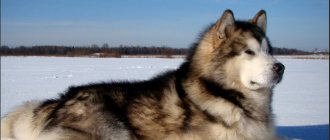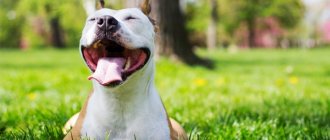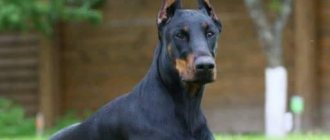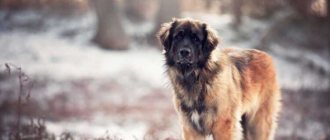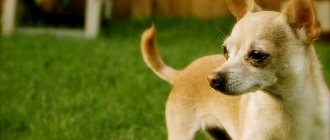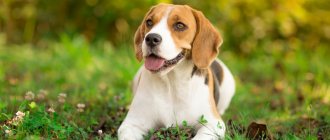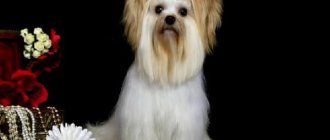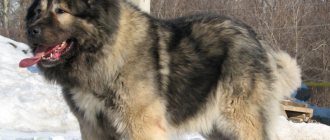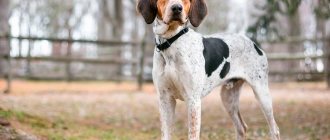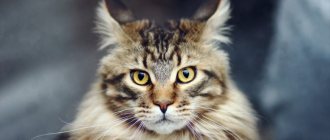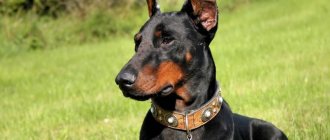Recognized throughout the world, the Chow Chow is a legend that is revered and somewhat shunned. There is too much significance hidden in this breed... there are too many myths surrounding the “bears” and it’s hard not to believe at least one of them. Family pet, companion, guard and protector, loyal, brave, wayward lion in a dog's body.
This is interesting! Before receiving the name Chow Chow, shaggy lions were called barbary dogs and even Tibetan Mastiffs. The “similarity” with the latter is explained by the conservative life of Tibet, scanty data on the breed and the existence of giants with red coat color.
History of the Chow Chow breed
White Chow Chow
Today there is no reliable information about when exactly the history of the Chow Chow began. But the fact that it dates back several thousand years is beyond doubt. According to some data, back in the 3rd millennium BC. e. in the palace library of the Chinese emperors there were records about this amazing breed, which, unfortunately, have not survived to this day.
One version of the origin of the breed says that the first dogs of this type appeared in China as “gifts of peace” that the Mongol conquerors presented to the emperor. The bear dog came to the Mongols as a military trophy during clashes with the indigenous peoples of Siberia. Archaeological finds confirm that the ancestors of the Chow Chow lived in this territory.
The question of the genetic roots of the representatives of the breed remains open to this day. Many experts are inclined to accept the version about the origin of the chow chow from polar wolves. The fashionable legend that the first dogs of this breed appeared as a result of an interspecific crossing of a husky and a polar bear does not stand up to criticism.
Once in China, Chow Chows were initially the property of only the courts of high-ranking nobles. But gradually interest in animals faded away, and dogs spread throughout the country, they could even be found in the homes of poor Chinese. Control over the purity of blood was lost. The situation was saved by the monks of Buddhist monasteries in Tibet, Manchuria and Northern China, who carried out careful selection work and kept pedigrees of blue and black chow chows.
Europe greeted the “bear” dog as a strange beast from the distant Celestial Empire. The first “fluffies” appeared here in 1780 and for almost a hundred years they were perceived only as exotic animals. The situation changed in 1865, when Queen Victoria, fascinated by the plush miracle given to her, showed interest in the breed. In 1887, the British began breeding Chow Chows, and eight years later the breed standard was approved and the first Chow Chow Club appeared in the Old World.
The Russian history of the breed goes back about eighty years, when the animals appeared in the Soviet Far East. Later, after 1945, some of the dogs were brought to the USSR from the eastern regions of Germany. A more or less stable population was formed only in the 60s of the last century. It became possible to get closer to world quality standards for the breed only after 1976, when purebred Chow Chows from recognized and titled producers were brought to the Leningrad Kennel Club.
Chow-chow female and male
Chow chow puppies
Historical reference
The Chow Chow dog received its name long before the birth of cynology. If we translate the name literally, the breed can be called the Shaggy Lion or the Dog of the Tang Dynasty. Both names are quite honorable, especially considering that during the Tang Dynasty, China was at the peak of its development and power.
Little is known about the genealogical origin of the breed. Two main versions say that the Chow Chow dog breed belongs to the group of aboriginal Spitz dogs or comes from the Molosser family, more precisely, from the Tibetan Mastiff. The relationship with Spitz dogs is seriously questioned, since the difference in the structure of the dogs is visible to the naked eye. Much more interesting are the legends about the origin of shaggy lions. Since dogs have a black and blue tongue, the semantic load is tied specifically to this feature.
So, the Chinese believe that Chow Chow had the honor of licking the sky at the time of the birth of existence. It is difficult to create a world, and the one who was doing this was carried away by the beauty of the stars, a piece of the sky fell to the ends of the earth, the dog arrived in time, licked the sky and its tongue turned blue.
Koreans claim that dogs are descended from bears. One day, the gourmet bear got so carried away by eating strawberries that he was reborn into a Chow Chow. A blueberry-colored tongue is strong evidence. Additional arguments are the “clubfooted” gait and independent disposition.
Even the official history of the breed considers the possibility that the blue tongue is a legacy from already extinct wolves that lived in the Arctic. We will no longer know whether this is true or not, but the relationship with wolves is not zealously disputed (but whether they were polar is unknown).
Restoring the life path of Chow Chow is impossible, since one of the Chinese rulers managed to destroy almost all the chronicles and literature of his country. It is known that the Chinese kept stud books on dog breeding... but by the will of the ruler they set everything on fire. Archaeologists managed to discover a figurine (220 BC), which, without a doubt, captured the face of Chow Chow. Historians also confirm the existence of records of Tibetan and Mongolian hunters, which described powerful hunting dogs with black tongues. By the way, the origin of these four-legged animals was associated with China and Tibet.
The reign of the Tang Dynasty marked a new stage in the history of the breed. Knowing that Chow Chows were successfully used to hunt birds, deer, bears and even tigers, the rulers issued a decree establishing an imperial nursery. By the way, historical writings say that Chow Chow attacked large predators without fear and held them until the hunter arrived. Facts of dogs working in sleds to transport goods are also mentioned.
The characteristics of the breed have been instilled in Chow Chows for centuries. It is interesting that after receiving the status of an imperial dog, monasteries began breeding four-legged dogs. All matings and litters were recorded in journals, essentially stud books. To eliminate risks, the monks exchanged producers and added fresh blood to their nurseries.
It is interesting that 50–60 absolutely identical dogs (in structure and coat color) could live on the territory of the monastery. A significant role was also played in the upbringing of the tailed animals; they were all obedient, but not limited in making their own decisions. How the monks achieved discipline remains a mystery, because living adult, mature male dogs in the same territory is quite a risky undertaking.
Chow chows received a ticket to the big world after meeting the British, or rather, one of the English. Taking advantage of his official position, Abshtein K.G. came to the territory of the monastery “in peace” and was shocked by the number and perfect similarity of dogs in the monasteries. After they learned about the incredible tailed creatures in England, little remained to be done. The first Chow Chows that came to Great Britain were a deep blue color.
Today, the Chow Chow is recognized by the FCI (International Canine Organization) with breed standard No. 205. In addition to the classic, fluffy type, the description of the breed includes a short-haired variety - Smooth. To the delight of city residents, a dwarf Chow Chow was also bred. The breed is not yet recognized and is in its infancy, and breeders emphasize that their ultimate goal is to soften the character and reduce the dogs to the size of Pomeranians.
Why "chow-chow"?
As well as versions of origin, there are several interpretations of the name of the breed.
- Thus, the word “chow” in Chinese means “an animal that can be eaten.” And although gastronomic preferences for dog meat are more likely to be typical of Koreans, China has also never disdained this dish.
- However, the same Chinese have the word “kau” - “dog”, which is very close in sound to “chow”. The version is less bloodthirsty, therefore more popular.
- The rich Chinese language gives us another explanation. The word "Chow" denotes a dog distinguished by great strength and courage - these are the traits that are characteristic of real Chow Chows.
- The European version refers us to the English “chow-chow” - this was the name of special premises on merchant ships that transported dogs of this breed across the ocean.
Vaccination
In general, the vaccination schedule is similar to that applicable to other breeds:
- For rabies, the first injection is given at 12 weeks, then repeated a year, carried out annually.
- They are vaccinated against plague at 8 weeks, revaccinated every year, and repeated every year.
- For parainfluenza, an injection is given at 8 weeks, then repeated a year, like every subsequent year of the dog.
- Protect against enteritis at 10 weeks, re-introduce a year, repeat annually.
- Protect against leptospirosis at 10 weeks, repeat at 12 months, then annually.
- The microsporia vaccination is given at 28 weeks, then repeated annually and annually.
- The vaccine against trichophytosis is given at 28 weeks, a year and annually.
Chow Chow Appearance
Fluffy handsome man
The Chow Chow is one of the most recognizable dog breeds in the world. Amazing fur and dark tongue are the reasons for the animals' enduring popularity.
Height
The height at the withers of a male is from 48 to 56 cm, of a female - 46-51 cm.
Weight
An adult male weighs 25-32 kg, a female – 20-27 kg.
Head
The Chow Chow's skull is flat, wide, with good filling under the eyes. The stop is not pronounced.
Muzzle
Wide, medium length without a “foxy” point. The nose is wide and large, usually black. For fawn and almost white dogs, a light color is allowed, and for cinnamon (cinnamon color) and blue chow-chows, a natural shade of the lobe is allowed. The palate, lips (preferably, and gums) are black. The tongue is blue-black.
Eyes
Oval, medium size. The pupil is clearly visible. Chow-chows of blue or cinnamon color may have eyes that match the color of their coat.
Ears
Thick, small in size, rounded at the ends. Wide set, erect, but slightly inclined towards the eyes, which gives the muzzle a frowning expression.
Neck
Harmoniously curved and well set on the shoulders. Powerful, not short.
Chow chow muzzle
Back
Straight, short, strong with a powerful loin.
Breast
Deep, well developed with pronounced but not barrel-shaped ribs.
Tail
The Chow Chow's tail is set high and lies on the back.
Front legs
Absolutely straight, medium length. The backbone is strong.
hind legs
Black chow chow
Powerful, medium length. The angles of the hock joints are minimal, which gives rise to a “stilted” gait characteristic only of this breed.
Paws
The Chow Chow's paws are small, rounded, and raised at the toes.
Wool
Long – very thick, straight and erect with fairly coarse topcoat and soft undercoat. It forms a characteristic “lion’s” mane around the neck, and long “pants” on the back of the thighs are well defined. Intentional shortening of hair that changes the appearance of the dog is under no circumstances allowed.
Short (smooth) – very thick, has a plush structure. The hair is located perpendicular to the body.
Color
Be sure to have uniform pure colors - black, fawn, cinnamon, red, especially valuable - blue and white. Shades of the main color are allowed, but never spots.
Any deviation from the standard is a deficiency or a disqualifying feature, depending on the degree of its manifestation.
Types of crossbreeds
Mixed breeds are dogs born as a result of crossing representatives of two different breeds. Such matings may be unplanned or carried out specifically to produce a new breed with improved conformation and character.
Chaski
Husky and Chow Chow mixes usually have a red and white coat color, blue eyes, and an elongated muzzle.
Chaskies are taller than Chow Chows, they have a soft, pleasant character, they are friendly, affectionate and loyal to their owner..
Chow chow + shar pei
Puppies born as a result of such mating have an independent character, good security and watchdog instincts.
Visually, they look like sharpeis overgrown with fur; their maximum height is 53 cm and their weight is 20 kg..
With a shepherd
These mestizos grow up to be good watchmen, security guards and hunters . They are friendly, intelligent, curious, vigilant and always on the alert. They have an elongated, thick, fluffy coat, inherited from the Chow Chow, most often of a black-and-white color.
Photo of an adult chow chow
Factors influencing lifespan
The life expectancy of dogs is influenced by factors:
- Physical development;
- Does the animal perform loads appropriate for its age and breed;
- Complete rest;
- A balanced diet enriched with nutrients;
- Sufficient communication and attention.
All these quality indicators of life depend 100% on the owner. The way he takes care of his pet shapes the animal’s resistance to stress and various diseases.
A balanced diet from birth lays the foundation for the pet’s physical health for the rest of its life and even into old age. An older dog should be fed soft food to avoid problems with teeth and swallowing.
In old age, animals can suffer from various diseases, most often deteriorating hearing, vision, and disruptions in the urinary system.
Another problem that can significantly reduce the age of any animal is excess weight. Its excess has a bad effect on the pet’s health, affecting the cardiovascular system and bone structure. It is necessary to control the weight of the animal, especially in old age.
Regular medical examinations, vaccinations, timely contacting a veterinary clinic in case of problems - this is what will keep your pet in the right shape. Constantly caring for your pet throughout its life can significantly increase its cycle.
Character of the Chow Chow
As original as the appearance of the Chow Chow is, its character is equally non-standard (as applied to dogs). People who know about the chaushka first-hand claim that it is an arrogant and heartless animal, and the owners of these unusual dogs unanimously speak of the kindness, devotion and responsiveness of their pets.
Chow chow with a child
The main character traits are independence, poise and dignity. This dog will even show love for its owner with special restraint, hiding endless devotion inside. Like all large dogs, the Chow Chow independently chooses the leader of the pack. And it is not at all a fact that it will be the one who brought the puppy into the house. Other household members will also receive their share of favor and courteous treatment, but the animal’s heart will belong only to the “leader” all its life.
External manifestations of love are very restrained. The dog whines almost inaudibly and lightly nuzzles its owner. Delight from communication can also be indicated by a barely noticeable twitching of the tail.
Dissatisfaction usually manifests itself in a dull growl, which, depending on the degree of concern of the dog, has different shades.
Newborn chow chow
All Chow Chow owners note an amazing, almost telepathic ability to sense the owner’s mood if he is upset or unhealthy in some way. But this dog will not understand and will not approve of excessive emotionality and hot temper.
If you have a child in your house, explain to him that this stuffed animal is not a toy at all and will not tolerate pain and excessive pranks even from members of his pack. If a child offends an animal, he will never be able to find a common language with him.
The Chow Chow's attitude towards strangers is always wary and distrustful. The dog usually does not show aggression, but it will not accept unsolicited affection from a stranger.
Relationships with other animals cannot be called simple. Chaushka will love the cat she grew up with, while the tailed one seen on the street will be pursued by her at every opportunity. They usually show no interest in oncoming dogs. If the first acquaintance does take place, then the decision made by the Chow will never change - either it is an enemy, or a friend, or just an acquaintance who just needs to “just politely nod in response.” Of the other dogs you keep in your home, the Chow Chow will only tolerate a member of its own breed of the opposite sex.
The Chow Chow does not celebrate a coward. If aggression is shown towards itself, the dog will fight to the bitter end without hesitation. Powerful jaws, large size and thick fur that protects against bites are good arguments in any fight.
A chow will rush to protect its owner without hesitation, even if it has not been trained in security work. He just loves you and is ready to give his life for it.
Which dogs live longer - neutered or unneutered?
Neutered dogs eliminate the risk of developing diseases of the genitourinary organs, prostatitis and prostate adenoma. They live 2-3 years more.
After castration, the owner must adjust the dog’s diet. She ceases to need large amounts of proteins and carbohydrates. Reducing portions and redistributing foods will prevent possible obesity.
Animals do not lose their guarding and hunting qualities. There is a decrease in aggression towards other dogs and attraction to females during the period of heat.
Education and training
Outwardly resembling a huge plush toy, Chow Chows are distinguished by a very firm and even somewhat wayward character.
Chow chow on a leash
Raising an obedient dog turns out to be a task that requires a lot of patience, dedication and consistency.
Raising a Chow Chow puppy should start from a very early age. Nature has endowed this cute fluffy ball with such willpower and integrity of character that only a true leader will obey the chow. Moreover, your leadership should be calm, confident and not subject to the slightest doubt. A hysterical aggressive person will never cope with this dog. Flirting and lisping will also not achieve results. The pet, sensing the weakness of the owner, will itself take the place of the leader and it will be almost impossible to make changes to such a hierarchy.
For successful upbringing, it is necessary to socialize the animal as early as possible. Walk him in crowded places more often so that the puppy gets used to the idea that there are many strangers besides you. This will gradually level out the innate hostility towards strangers. Chow Chows are very jealous of the inviolability of their home. A situation when guests come to the house and (in the puppy’s opinion) allow themselves to move uncontrollably around its territory can cause stress in the dog and a subsequent aggressive reaction, so you should try as quickly as possible to teach the baby to be calm about new faces, smells and voices .
Wet chow chows
A big plus in raising Chow Chows is their innate cleanliness. The puppy very quickly understands where to go to the toilet and learns to be patient from walk to walk. But do not abuse this ability - after sleep and every feeding, the dog should be taken outside.
Training a Chow Chow at home seems to be a very problematic undertaking. A representative of this breed simply will not follow orders that he considers incomprehensible or stupid. If you don’t have enough time or feel even the slightest doubt about your abilities, it’s better not to start the task. Immediately place your pet in the hands of an experienced instructor, otherwise it will be extremely difficult to correct the consequences of training.
Experts note that the execution of even a simple command takes place in several stages. First, the dog will evaluate the appropriateness of the command in a given situation, then decide how determined you are to carry it out, and only after realizing that your willpower cannot be overcome, will it perform the required actions. If you give up, the chow will continue to do its own thing. The situation is even more difficult with the execution of service commands, especially endurance. Well, the animal doesn’t understand why it needs to stay in the same position for a long time. And if he doesn’t understand, it means he won’t do it.
The main difficulties in training Chow Chows are encountered when working with males. Girls are more flexible, obedient and sociable, and do not strive for leadership in the pack as much as the stronger sex.
Movements
The Chow Chow is distinguished by a characteristic stilted gait, when the movement of the hind leg is carried out from the hip, and short steps. The stilted gait is best seen when viewed from the side. The dog moves with a fast and short step without a wide extension of the hind limbs, while the croup does not sway much either vertically or horizontally. The hind limbs move like a pendulum, lightly touching the ground with their paw pads. A powerful push of the hind limbs is observed. The limbs are not close together. When viewed from the front, the forelimbs should not describe a semicircle during movement and the axis of the shoulder should move strictly forward. When moving, the front and rear legs are parallel to each other. As the speed of movement increases, the limbs shift slightly towards the center of gravity. Waddle movements are not allowed.
Care and maintenance
Chow chow at a puppy show
The conditions of a city apartment are quite suitable for keeping a chow chow. This dog has a balanced and calm character and, when alone, will never howl loudly, annoying neighbors, or damage furniture. The chaushka is also amazingly clean, which all owners note with special pride.
Thanks to its special structure, the coat of dogs of this breed practically does not get dirty, and when dirty, it cleans itself perfectly, so experts do not recommend bathing your pet more than 2-3 times a year. Of course, before entering the exhibition ring you cannot do without this procedure.
Contrary to popular belief, you should not brush your dog every day when it is not shedding. It is enough to perform this procedure once a week using a sparse comb. The Chow Chow's coat is not prone to matting. The exceptions are the armpits and behind the ears. These areas need to be monitored more closely. During the molting period, the fallen undercoat remains on the coat and is easily removed by combing, which these days requires systematicity.
Connoisseurs of the breed note that richer, longer and denser hair is characteristic of males. A chow chow that spends a long time on the street or is kept in a specially equipped enclosure looks even more luxurious. This applies to adult dogs. In puppies up to six months of age, the body is covered with fluff, which quickly falls off, gets wet and dries very poorly. You should carefully look after the condition of your baby’s coat and try not to bathe him until the first adult shedding.
The procedures associated with cleaning a dog’s ears and teeth are no different. But trimming the claws is usually not necessary - due to the structure of the paw, they grind well on the ground. The dewclaws require more attention, especially in winter. The dog's eyes need daily care - they need to be wiped with a cotton swab dipped in a special solution.
Chow chow puppies having a meal
To feed a chow chow, it is optimal to use premium dry food with a reduced fat and protein content. This can be a mixture for animals predisposed to allergies, or any other dietary composition. Even three-month-old babies can be switched to a menu for adult dogs, since puppy food is usually saturated with fat, but this is not very good for a chow chow.
If you prepare food for your pet yourself, you need to make sure that the diet does not contain a lot of fats and carbohydrates. Sea fish and meat are preferable raw, and among vegetables, cabbage, lettuce and other leafy crops will bring the greatest benefit. Cereals are not welcome, with the exception of buckwheat and rice in very small quantities. Poultry tubular bones should be completely excluded. Improving the quality of the coat is facilitated by introducing a small amount of vegetable oil into the diet.
As for the diet, it should be remembered that it is better not to overfeed the chow chow, and the possibility of constant “snacks” between feedings should be excluded. In any case, you need to carefully monitor the diet of dogs of this breed. Chow chows are prone to allergic reactions, and any imbalance in the diet, especially an excess of carbohydrates, can lead to undesirable consequences.
Chow Chow puppies are not suitable for long distance runs or long hikes. It’s better to let your baby off the leash so that he can regulate his own physical activity.
Choose a collar for your pet responsibly. The usual one will not work - it wipes out the hair and the dog’s appearance noticeably suffers. The best option seems to be a narrow leather or fabric collar or a special harness.
A well-groomed and healthy dog is the best recommendation for you as an experienced and skillful owner!
Types of dogs
There are 2 types of chow chow:
- shorthair (smooth);
- long-haired.
The first type is characterized by a rather short guard hair, but a fairly dense undercoat; the second type is characterized by both a thick, soft and fluffy undercoat, and an abundant, rather long and dense outer coat.
Shorthaired Chow Chows are more sensitive to lower air temperatures and have a harder time withstanding cold, but feel better in hot weather..
In addition, there are mini Chow Chows, which differ from standard representatives of the breed in being smaller in size.
Chow Chow Health and Diseases
Chow chows are dogs with good health. However, there are a number of hereditary diseases that are most common in representatives of this breed. These include atopic dermatitis, hereditary myopathy and entropion.
I'm not fat, I'm fluffy
Hereditary myopathy manifests itself in a decrease in muscle tone, impaired muscle contraction, and atrophy. The danger of the disease is that it affects all skeletal muscles. The disease is manifested by difficulty in activity - the animal gets up with difficulty, movements are constrained, during walks the dog may even fall and not get up immediately, the hind legs begin to move in “hare hops”. More often, such problems begin to appear at low air temperatures. If any of these symptoms appear, you should immediately contact your veterinarian. The dog should be kept warm. The disease is dangerous as it can lead to severe complications and even death of the animal.
Atopic dermatitis is a hereditary allergic disease. Accompanied by severe itching and changes in the skin, reminiscent of eczema. The main symptoms are almost incessant scratching and licking of the groin, axillary and interdigital areas of the body. According to statistics, it occurs in almost 15% of dogs of the Chow Chow breed (bitches are more often affected). Advanced dermatitis can cause otitis media. For more effective treatment, the allergen should be determined clinically or by exclusion.
Entropion of the eyelid is manifested in the pathological location of the eyelid, due to which the eyelashes turn towards the eyeball. Constant friction of eyelash hairs on the cornea of the eye not only constantly irritates the eye, which causes profuse lacrimation and purulent discharge, but can lead to ulcerative keratitis, perforation of the cornea and even blindness. Treatment is usually surgical, although for puppies it may be sufficient to invert the edge of the eyelid and secure it securely with several sutures.
Like most large dogs, Chow Chows are not immune to hip dysplasia. Such a defect can be caused at the genetic level and manifests itself in a predisposition to subluxation in this joint. If your guinea pig begins to limp on its hind legs and stagger when walking, it is necessary to urgently take an x-ray, since clinical tests do not reveal the disease. A sick animal should be limited in its movements and protected from stress. Depending on the stage of the disease, various medicinal and physiotherapeutic methods are used or surgical intervention is used.
A guarantee against the occurrence of other canine diseases can be timely vaccination, control over a balanced diet, and the use of vitamin preparations.
Life expectancy for boys and girls at home
The average life expectancy of a Chow Chow is 11-13 years. However, some of the representatives of this breed can live up to 15 years or even more. While other dogs die very early - due to accidents or illnesses.
Most professional dog trainers and breeders believe that the minimum life expectancy of these dogs is 8-9 years, the average is 11-13 years, and the maximum life expectancy for chow chows is 15-16 years.
However, the life expectancy of dogs depends only slightly on gender. Both boys and girls Chow Chows can live long lives. In the same way, the early death of a dog is usually least associated with the gender of the pet.
However, according to statistics, the cause of rather early death in bitches is often diseases of the reproductive system, such as advanced pyometra or malignant tumors.
On the other hand, oncological diseases of the genitourinary system also occur in male dogs.
Castration or sterilization carried out at a young age completely eliminates such risks and can help prolong the life of the animal.
“On average, chow chows live 11-13 years, however, such a life expectancy is only possible if the dog is provided with quality care and feeding. Much here depends on heredity and which line the pet belongs to. Chow Chows that come from long-lived lines have a better chance of surviving to this age than the descendants of short-lived and sickly dogs. And, of course, no pet can live long without the love of its owner. When a dog feels abandoned and unwanted, he becomes decrepit and dies much faster than his peers, who feel the love and care of their owners until the last days of their lives.”
How to choose a puppy
When solving the problem of choosing a puppy, you have to find the answer to a number of questions.
Chow-chow puppy with mom
- Who do you want next to you - a champion dog, a winner of numerous exhibitions, or just a pet? The Chow Chow puppy you are adopting “for fun” may have deviations from the breed standard (spotted tongue, drooping ears) and even more serious disqualifying signs (narrow chest, undershot or overshot, incorrect tail setness). Most often, all of the above has nothing to do with health conditions, but are simply deviations in appearance and are quite acceptable for exclusively “pet” pets. Choosing a show puppy is more difficult. In this case, it is better to seek the help of a specialist or take into account the recommendations of the breeder. It is important to know that it is better to choose a show-class dog at the age of about 12 weeks, when its “pedigreed” traits are more clearly visible.
- Girl or boy? Males are better suited for participation in exhibitions - they have fewer deviations from the breed standard, look more impressive and respectable. A female chow chow is a wonderful choice as a companion dog. She is more affectionate, gentle and sensitive than the male. The bitch's attachment to the owner and members of his family is much more pronounced. The disadvantage of keeping them is the problems associated with the physiology of the animal.
- At what age is it better to pick up a baby? For a show career, it is better to take a puppy that has grown up to about six months. At this age, the risks of making mistakes in assessments and forecasts for the success of an exhibition career are minimized. You can buy chow chow for your home at an earlier age. If there are small children in your home, who will undoubtedly see the dog as an incredibly interesting toy, then wait until the puppy is 4-5 months old - it will be easier for him to adapt to the not always thoughtful behavior of young household members.
- Chow with long hair or smooth? Both of them have absolutely equal rights in terms of thoroughbred qualifications and enter the ring on absolutely equal rights. Smooths are easier to care for - they have much less hair and do not need daily brushing. Many people also note the more sociable nature of smooth-haired Chow Chows.
- Where to get a puppy? The answer is obvious - only in a specialized nursery or from a breeder with a good, time-tested reputation.
Milaha
What to look for when choosing a baby?
- The color of the fur on the face, paws and under the eyes. This is exactly the color your Chow Chow will have when he grows up.
- A six-week-old puppy begins to develop baby teeth. The mouth, including the palate and tongue, should be blue-black, the tail held high, and the ears fully or partially raised.
- Observe the animal and determine its temperament. Cowardly aggressive puppies should be rejected by you immediately.
- Assess the condition of the baby's eyes: is there any purulent discharge or signs of active lacrimation. Examine the eyelids - one of the typical diseases of the Chow Chow, entropy (entropion of the eyelid), can appear already in puppyhood.
Varieties
In total, there are 5 breeds bred on the basis of the Pinscher, each of which should be discussed separately:
- The Miniature Pinscher is the smallest of all Pinschers. He has strong limbs, a powerful body with well-developed muscles. The fur is short, its color (according to the standard) can be red or black. According to the standard, these miniature dogs must have their ears and tail docked.
- The Doberman is a pet of medium height, its height at the withers usually does not exceed 0.5 m. This breed was developed by Friedrich Doberman (that is why this breed was named after him). These dogs are service dogs, they have a well-developed sense of smell, they are hardy, intelligent and at the same time very elegant. They are considered quite aggressive.
- The German Pinscher is a dog with an athletic build. His ears are high and erect, his muzzle is elongated. These dogs are smooth-haired; according to the standard, the color can be black or red.
- The Australian Pinscher was a herding dog in the past; Australian farmers used these Pinschers to help guard herds of sheep, as well as to catch rats and other small rodents. The fur is long and can have different colors.
- Affenpinscher are miniature pinschers that look like primates (hence the name of the breed). The main feature of his appearance is his fluffy beard. These pinschers have floppy ears and very expressive eyes.
Photos of chow chow puppies
Age compared to human years
| Chow Chow age | Person's age |
| 1 year | 15 years |
| 2 years | 24 years |
| 3 years | 28 years |
| 4 years | 32 years |
| 5 years | 35 years |
| 6 years | 45 years |
| 7 years | 50 years |
| 8 years | 55 years |
| 9 years | 61 years old |
| 10 years | 66 years old |
| 11 years | 72 years old |
| 12 years | 77 years old |
| 13 years | 82 years old |
| 14 years | 88 years old |
| 15 years | 93 years old |
How much does a chow cost?
Chow chow has become increasingly popular in recent years.
This dictates high prices for puppies on the one hand, and on the other hand, it increases the likelihood that unscrupulous breeders will sell you a dog of low quality. If you are not interested in the dog’s pedigree and are ready to accept the presence of defects and even disqualifying characteristics in your chosen one, then buying a small chow chow can cost you approximately 5-7 thousand rubles. A puppy without a passport, but fully meeting the breed standards, will cost significantly more – 20-25 thousand. For a show-class representative purchased from a specialized nursery or from well-known breeders, you will have to pay at least 40 thousand rubles. A female, especially of elite blood, will cost more than a male.
Optimal nutrition
Puppies should be weaned off their mother's milk gradually by introducing fermented milk products into their diet. Porridge made from rice, buckwheat and barley will help you get stronger, gain weight and develop muscles. Vegetables and fruits are suitable as natural sources of vitamins. Chow's favorite foods are apples, raspberries, pears and bananas.
As the puppy gets older, you need to feed the puppy less often, but increase the amount of food. Gradually you can switch to dry food. For kids, you can soak it first until they begin to chew it on their own. Dry mixtures should be chosen as high quality as possible. They are completely balanced and contain all the necessary vitamins and minerals.
The basis of natural food should be lean meat. It is complemented by:
- buckwheat, rice, oatmeal, dried rye bread;
- vitamins and minerals;
- boneless fillet;
- vegetable oils (sunflower, olive, flaxseed);
- dairy products, cheese.
Important! The daily feed intake should not exceed 3% of the total weight of the animal.
